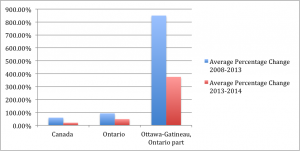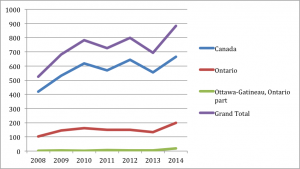Over the past six years there has been a decline in the production of family housing in Ottawa because of skyrocketing housing costs. According to data from the City of Ottawa’s Open Data website, today you are unlikely to own your first home until your mid-30s or later. “Costs have now reached the point where home ownership is beyond the reach of many young families,” says Shirley Morrison-Hawes of the Greater Ottawa Home Builders’ Association. “The term “affordability” is no longer restricted to publicly funded housing projects and is of real concern to all but the very wealthy.”
Currently in Ottawa the majority of homeowners are above 35 years of age and live primarily in the downtown core. Gloucester-Southgate, Rideau-Rockcliffe, and Rideau-Vanier have the highest concentrations of this demographic of homeowners. The exception is Orleans, which also has a fairly high number.

Meanwhile, those who own a home but are 34 years old or younger populate the Somerset and Knoxdale-Merivale wards in higher numbers. A fair number also live in the Rideau-Vanier ward. For both demographics, the wards on the outskirts are the least popular; Rideau-Goulbourn and Osgoode.

This high city center concentration is becoming problematic. “Many of the smaller and mid sized builders in Ottawa have avoided the risks associated with land development by paying a premium to purchase serviced lots from larger integrated land development companies. This practice is disappearing since the City of Ottawa has refused to expand the urban boundary,” says Morrison-Hawes. According to the Greater Ottawa Homebuilders’ Association, 14.9% to 26% of a home’s cost is for serviced land. The actual construction costs are not the problem, as they have stayed constant for many years. “The real problem is the increase in fees and taxes imposed on homeowners by the government,” says Morrison-Hawes.
“Ottawa has many heritage districts, in which the homes often have a higher retail value,” writes Leslie Maitland of Heritage Ottawa. “That’s another reason why people over 35 can afford to live in these areas.” According to data from Statistics Canada, Ontario has the highest percentage of young people (early to late 20s) living at home, at 50.6%.
The relatively higher concentrations of both young and mature homeowners in and around the city center can be attributed to the fact that most jobs are located there. There are often a variety of housing options, but young people are not buying homes in the same way they were 20 years ago. As one can see from the provided maps, homeowners 35 and older however prefer neighbourhoods that are lower density, whereas those 34 and under prefer higher density areas with more apartment buildings and semi-detached homes. According to Statistics Canada, nearly half of all Canadians living in metropolitan areas live in neighbourhoods that are low density.
Based on current trends, the age of people purchasing their first home is only likely to increase in the next few years.









